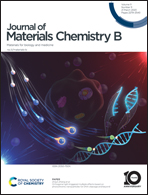Orthogonal light-triggered multiple effects based on photochromic nanoparticles for DNA cleavage and beyond†
Abstract
Efficient and spatiotemporally controllable cleavage of deoxyribonucleic acid (DNA) is of great significance for both disease treatment (e.g. tumour, bacterial infection, etc) and molecular biology applications (e.g. gene editing). The recently developed light-induced cleavage strategy based on catalytic nanoparticles has been regarded as a promising strategy for DNA controllable cleavage. Although the regulation based on orthogonal light in biomedical applications holds more significant advantages than that based on single light, nanoparticle-mediated DNA cleavage based on orthogonal light has yet to be reported. In this article, for the first time, we demonstrated an orthogonal light-regulated nanosystem for efficient and spatiotemporal DNA cleavage. In this strategy, tungsten oxide (WO3) nanoparticles with photochromic properties were used as nano-antennae to convert the photoenergy from the orthogonal visible light (405 nm) and near-infrared light (808 nm) into chemical energy for DNA cleavage. We verified that only the orthogonal light can trigger high cleavage efficiency on different types of DNA. Moreover, such an orthogonal light-response nano-system can not only induce significant apoptosis of tumour cells, but also effectively eliminate bacterial biofilms.



 Please wait while we load your content...
Please wait while we load your content...